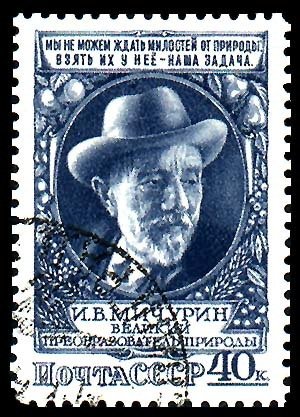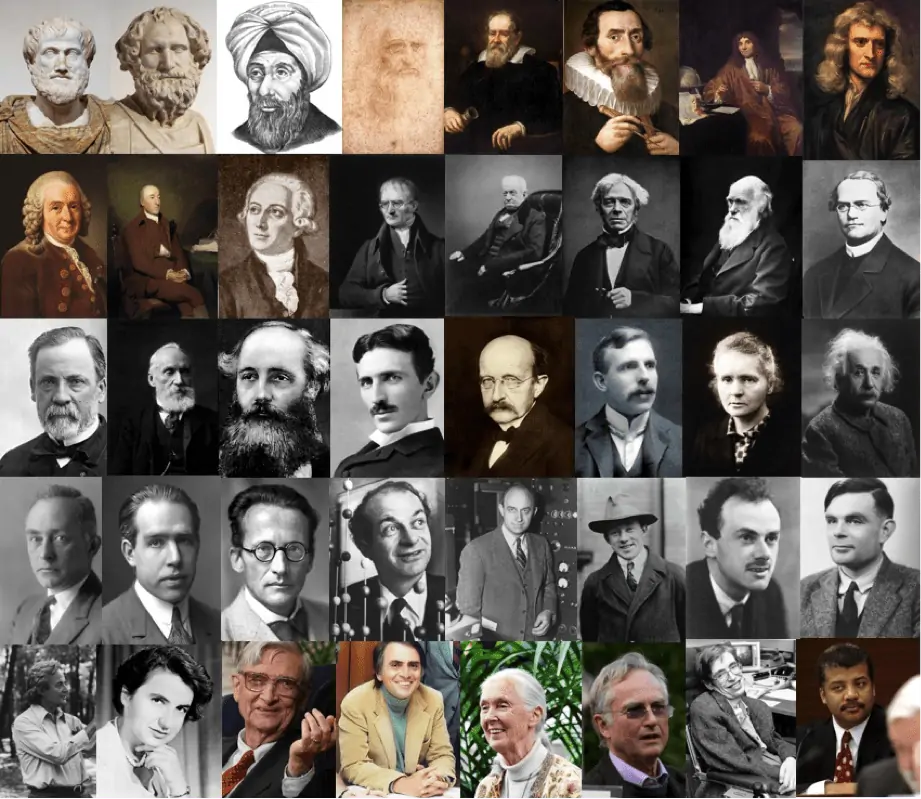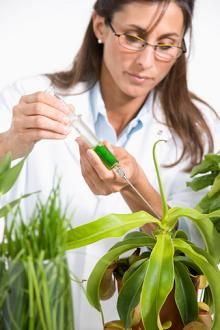Stamp: Ivan Michurin (1855-1935), Russian botanist and selectionist (Soviet Union, USSR 1949)
Ivan Michurin (1855-1935), Russian botanist and selectionist (Soviet Union, USSR 1949)
01 January (Soviet Union, USSR ) within release 10th Anniversary of Reunion of W.Ukraine and W.Belarus goes into circulation Stamp Ivan Michurin (1855-1935), Russian botanist and selectionist face value 40 Russian kopek
| Stamp Ivan Michurin (1855-1935), Russian botanist and selectionist in catalogues | |
|---|---|
| Michel: | Mi:SU 1353 |
Stamp is square format.
Also in the issue 10th Anniversary of Reunion of W.Ukraine and W.Belarus:
- Stamp - Coat of Arms of Byelorussian SSR face value 40;
- Stamp - Lenin's Mausoleum face value 40;
- Stamp - Vasily Williams (1863-1939), Russian and Soviet agronomist face value 25;
- Stamp - Soviet woman in Textile industry face value 20;
- Stamp - Soviet woman in Pre-school Education face value 25;
- Stamp - Soviet woman in the management of state affairs face value 40;
- Stamp - Women in Socialistic Agriculture face value 50;
- Stamp - Soviet schoolmistress face value 50;
- Stamp - Soviet woman in mass sport face value 1;
- Stamp - Stepan O. Makarov (1849-1904), Russian naval commander face value 40;
- Stamp - The Building Of Military medic academy face value 40;
- Stamp - S. Botkin, N. Pirogov, I. Sechenov & Military medic academy face value 50;
- Stamp - Miner with coal hammer face value 15;
- Stamp - Scientist at microscope face value 30;
- Stamp - Coat of Arms of the USSR face value 40;
- Stamp - Working people with May Day banner face value 40;
- Stamp - Soviet newspapers and works by Marx, Lenin, Stalin face value 40;
- Stamp - Alexander Popov, inventor of radio face value 40;
- Stamp - A.Popov shows the world's first radioset to admiral Makarov face value 50;
- Stamp - Alexander S. Pushkin (1799-1837), Russian author face value 25;
- Stamp - A.S. Pushkin among his friends in Kamenka face value 40;
- Stamp - Boldino State Literary Memorial and Museum of A. Pushkin face value 1;
- Stamp - Ivan Michurin (1855-1935), Russian botanist and selectionist face value 40;
- Stamp - Tugboat face value 40;
- Stamp - Vasily V. Dokuchayev (1846-1903), Russian geologist face value 40;
- Stamp - Vasily I. Bazhenov (1737/38-1799), Russian architect face value 40;
- Stamp - Alexander N. Radishchev (1749-1802), Russian author face value 40;
- Stamp - Khosta: Sanatorium of the Ministry of Communications face value 40;
- Stamp - Khosta: Sanatorium #3 of Trade unions of USSR face value 40;
- Stamp - Khosta: Sanatorium of power engineering specialists face value 40;
- Stamp - Zheleznovodsk: Sanatorium #41 of Trade unions of USSR face value 40;
- Stamp - Sochi: State Theatre face value 40;
- Stamp - Sochi: Frunze Sanatorium face value 40;
- Stamp - Makhinjauri: Sanatorium "Zelyony mys" of Trade Unions face value 40;
- Stamp - Kislovodsk: Sanatorium #1 of Trade unions of USSR face value 40;
- Stamp - Kislovodsk: Sanatorium #3 of Trade unions of USSR face value 40;
- Stamp - Ivan P. Pavlov (1849-1936), Russian physiologist face value 40;
- Stamp - The Globe belted with envelopes face value 40;
- Stamp - The Globe belted with envelopes face value 40;
- Stamp - Field-protective forestation face value 25;
- Stamp - Forest shelterbelts to collective farm fields face value 40;
- Stamp - Map of forest shelterbelts and field-protective forest face value 40;
- Stamp - Build ponds and reservoirs! face value 50;
- Stamp - Field-protective forestation face value 1;
- Stamp - Vasily I. Chapayev (1887-1919), Hero of Civil War face value 40;
- Stamp - Ivan S. Nikitin (1824-1861), Russian poet face value 40;
- Stamp - The building of Maly Theatre and Order of Lenin face value 40;
- Stamp - Maly Theater face value 50;
- Stamp - People's parade on Red square face value 40;
- Stamp - Cattle (Bos primigenius taurus), Sheep (Ovis ammon aries), M face value 40;
- Stamp - Gymnastics. Female gymnast on rings. face value 40;
- Stamp - Weightlifting face value 1;
- Stamp - Four-axle full-metal tramcar (MTV-82) face value 25;
- Stamp - Freight steam locomotive (class "L", config. 1-5-0) face value 50;
- Stamp - Coat of Arms and State Flag of the USSR face value 40;
- Stamp - Textile industrial complex. Cotton and trucks. face value 20;
- Stamp - Irrigation System face value 25;
- Stamp - The House of the Government of Tajik SSR in Stalinabad face value 40;
- Stamp - Medical college and Teacher's training college in Stalinabad face value 50;
- Stamp - Reunion of Western Byelorussia with Byelorussian SSR face value 40;
- Stamp - Worker with flag behind globe face value 40;
Stamp Ivan Michurin (1855-1935), Russian botanist and selectionist it reflects the thematic directions:
Famous People refers to the fame and public attention accorded by the mass media to individuals or groups or, occasionally, animals, but is usually applied to the persons or groups of people (celebrity couples, families, etc.) themselves who receive such a status of fame and attention. Celebrity status is often associated with wealth (commonly referred to as fame and fortune), while fame often provides opportunities to make money.
Commemorations are a type of religious observance in the many Churches of the Anglican Communion, including the Church of England. They are the least significant type of observance, the others being Principal Feasts, Principal Holy Days, Festivals, and Lesser Festivals. Whereas Principal Feasts must be celebrated, it is not obligatory to observe Commemorations. They are always attached to a calendar date, and are not observed if they fall on a Sunday, in Holy Week, or in Easter Week. In Common Worship Commemorations are not provided with collects or indications of liturgical colour. However, they may be celebrated as Lesser Festivals if local pastoral conditions suggest it.
In botany, a fruit is the seed-bearing structure in flowering plants (also known as angiosperms) formed from the ovary after flowering. Fruits are the means by which angiosperms disseminate seeds. Edible fruits, in particular, have propagated with the movements of humans and animals in a symbiotic relationship as a means for seed dispersal and nutrition; in fact, humans and many animals have become dependent on fruits as a source of food. Accordingly, fruits account for a substantial fraction of the world's agricultural output, and some (such as the apple and the pomegranate) have acquired extensive cultural and symbolic meanings. In common language usage, "fruit" normally means the fleshy seed-associated structures of a plant that are sweet or sour, and edible in the raw state, such as apples, bananas, grapes, lemons, oranges, and strawberries. On the other hand, in botanical usage, "fruit" includes many structures that are not commonly called "fruits", such as bean pods, corn kernels, tomatoes, and wheat grains. The section of a fungus that produces spores is also called a fruiting body.
A scientist is a person who researches to advance knowledge in an area of the natural sciences
Botanists study how plants produce food and how to increase yields, for example through plant breeding, making their work important to humanity's ability to feed the world and provide food security for future generations.





